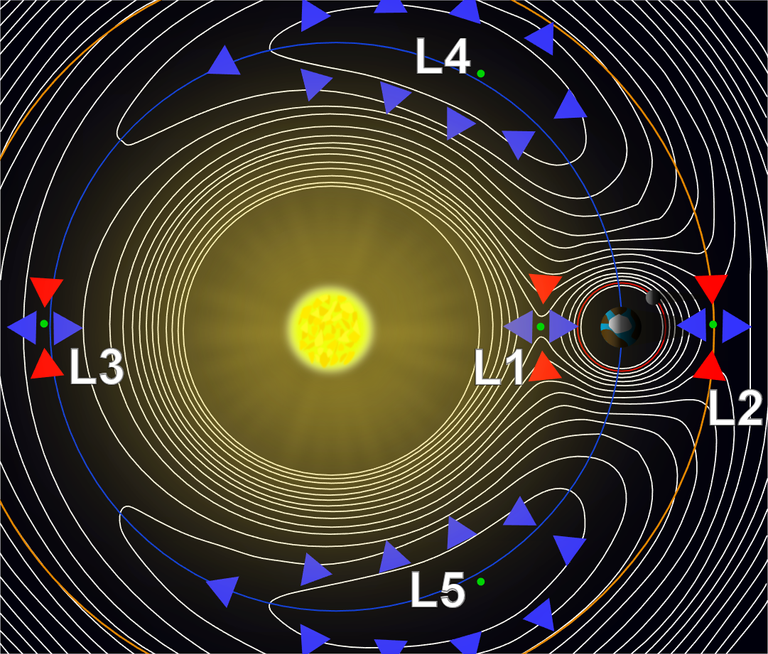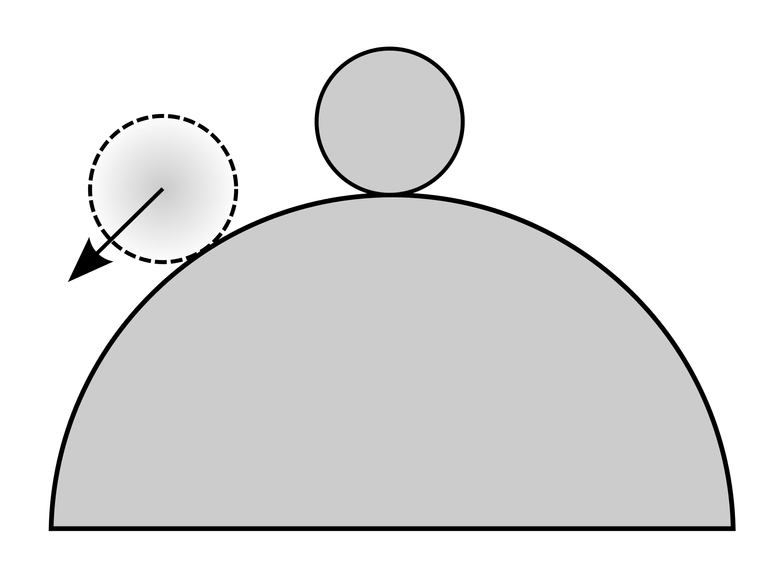Lagrange Points, The Parking Spots of the Universe
My goal was to show that the celestial machine is not so much a divine organism but rather a clockwork. --- Johannes Kepler
When talking about satellites, most people commonly know about existence of them in certain places, being Low Earth Orbit (LEO) and geosynchronous orbits. Well today I will introduce the lagrange points or also known as libration points, which would often appear in science fiction for reasons which I will explain today.
The Lagrange Points
The Lagrange points can be best described as the parking spots of the universe. Within a 3 body system (restricted 3 body problem) we try to find a perfect equilibrium of gravitational forces. The gravitational force reaches an equilibrium on 5 points, 2 of which become stable as long as the ratio between the two masses exceeds 25 (24.96 to be more precise). While kepler’s law state that the object in the higher orbit should move slower the gravity of 1 the of masses will tug it along always keeping it on the libration point.[1][2][3][4]
[source] [not drawn to scale]
The 3 of libration points (L1, L2, L3) are found along a line which can be drawn throughout the 2 masses, for earth-sun instance 1 is exactly on the opposite of the earth, 1.5 million kilometers in front and behind the earth. All of the points that line along with the sun on earth are deemed as unstable. Much better visualized in the picture prescribed above is the gravitational field, the best analogy I may give to describe on why these points are unstable is to imagine this, a satellite which is a ball in this instance is resting on top of a hill in a perfect but unstable equilibrium. If a force were to act on it, it would knock the satellite of the libration point shifting the entire orbit. . [1][3][4]
[source]
Libration points 4 and 5 in respect with the two bodies form equilateral triangles. In this instance the satellite travels around the barycenter of the two bigger masses. These points only are stable when the ratio of two ratio of the masses of the two objects is 24.96 or greater (This only applies in our solar system to Moon-Earth, Earth-Sun, and Sun-Jupiter). The best way to explain how these two lagrange points are stable is to take the analogy of the ball again, but instead replace the hill with a valley. In practice this means that if the satellite were to be tugged by the gravity or by angular momentum induced speed which will increase/decrease the speed of the satellite relocating it back to the libration point.[1][2][3][4]

What lays on each lagrange point
As lagrange points are stable, they may attract natural satellites. This is very true at least for lagrange points 4 & 5. Though it was a cliche for science fiction writers to make there be something at lagrange point 3, as people may fantasize that the perfect place to put an evil base would be out of everyone’s view (behind the sun). One of the most significant natural satellites that exist at lagrange points 4 & 5 is for the jupiter-sun system, this is where the trojan and the greek asteroids exist respectively. [2][4][5]
What are the uses for the lagrange points?
Lagrange Point 1: This point is an excellent place to study the sun as it is in orbit around the sun and has constant line of sight on planet earth. Space crafts such as Advanced Composition Explorer (ACE) are used to study the solar corona, solar winds etc. But it’s most important effect on everyday life of an ordinary joe are warnings in advance of solar storms, which prevents power grids overloads, communications being disrupted, saves astronauts and satellites.[6]
[source]
Lagrange Point 2: This point is used for to peer out onto the universe, this point is quite a bit away from earth. Meaning spacecrafts such as Herschel don’t get interfered by infrared radiation, which is ideal. Having spacecraft sit exactly at the point is not ideal, if a solar flare were to come it would disturb the communications which is disastrous. Spacecraft may be put under something called a Lissajous Orbit, which is a quasi periodic orbital trajectory (This also applies for points 1-3). These orbits help the space probes to stay out of the line of sight of the solar flare.[7][8][9]

Lagrange Point 3: This point has does not have any concurrent use. This is mostly due to it being hard to get there, and impractical to communicate with.
Lagrange Points 4 & 5: These points have not much use either, but they do attract natural satellites. Though it has been proposed to use these points for future colonies. [10]
Personal Comments
I wish to thank everyone that has followed me over the last two posts that I’ve created. I hope to create more under the near future, incase you are wondering I will put out 1-2 posts a week on various different topics. Just as I said previously please leave criticism of my writing as I am trying to improve. If you have anymore questions about the topics I’m addressing I will answer them for you (Or at this point any questions, which I will make a seperate post if I can’t cover it in the comments).
Full List of Sources I’ve used and may have not used tags for
https://en.wikipedia.org/wiki/Lagrangian_point
https://www.space.com/30302-lagrange-points.html
http://www.esa.int/Our_Activities/Operations/What_are_Lagrange_points
https://map.gsfc.nasa.gov/mission/observatory_l2.html
https://en.wikipedia.org/wiki/International_Cometary_Explorer
https://en.wikipedia.org/wiki/Herschel_Space_Observatory
http://www.sps.ch/en/articles/various-articles/the-herschel-space-observatory/
https://en.wikipedia.org/wiki/Lissajous_orbit
https://www.space.com/33503-earth-full-year-video-from-space-dscovr-time-lapse.html
https://en.wikipedia.org/wiki/James_Webb_Space_Telescope
https://wmap.gsfc.nasa.gov/media/ContentMedia/lagrange.pdf
http://www.srl.caltech.edu/ACE/ace_mission.html
http://ccar.colorado.edu/asen5050/projects/projects_2003/cain/
http://www.esa.int/Our_Activities/Space_Science/Herschel/L2_the_second_Lagrangian_Point
That's amazing @nonationnoborder!!!
The Parking Spots Of The Universe amazing
Make sure to follow to get more posts like these :D
You have done a great work.. Interesting
@originalworks
Fibbonacci, fractal clock work. Love this stuff 🙌💫✨